Launched for 2010, the
Polaris Rush aims to attract younger customers and revitalize the brand. The model not only met these expectations but also revolutionized the industry with its innovative style, ergonomics and rear suspension.
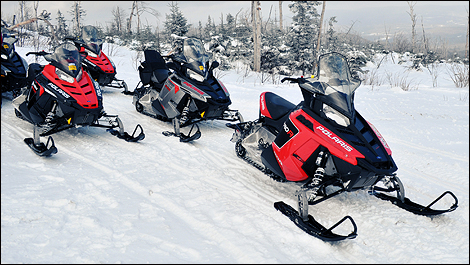 |
| Launched for 2010, the Polaris Rush aims to attract younger customers and revitalize the brand. (Photo: Pascal Bastien/Moto123.com) |
The Rush Pro-R offers the ergonomics of a snowcross sled thanks to raised handlebars and seat, a near upright steering column, wider floorboards and extra knee room that combine to make active riding easier.
Intricate suspension
Polaris did not reinvent the snowmobile, but the new Pro-Ride chassis, which is said to come from long, extensive development, looked extremely promising on paper. Unfortunately, when I first rode the machine, I wasn't particularly enthused with the progressive-rate suspension. Of course, there are plenty of improvements over the IQ architecture, including superior rigidity, better front suspension control and easier weight transfers resulting from the revised riding position (higher and closer to the front). Grip and steering precision are both enhanced. However, the effectiveness, travel and damping characteristics of the rear suspension on bumpy trails left me a bit disappointed.
Major upgrade
Never sitting still, Polaris quickly addressed the issue. The new 2011 600 and 800 Rush Pro-R models have been significantly upgraded with premium Walker Evans shocks and a revamped rear suspension featuring an improved slider and a non-progressive spring.
The latest evolution of the Pro-Ride chassis literally flies over bumps yet never sends the rider airborne, even at ultra-high speeds on a frozen lake riddled with ice bumps. Riding very aggressively over a succession of big bumps still leads the rear shock to bottom out, but the system effectively deals with most imperfections found on regulated trail networks. In fact, it offers one of the industry's best comfort/stability ratios.
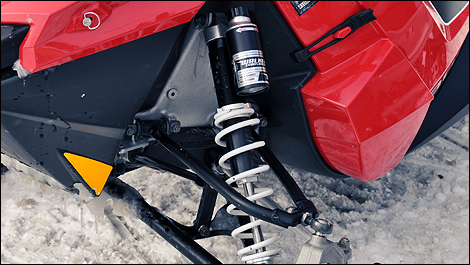 |
| The new 2011 600 and 800 Rush Pro-R models have been significantly upgraded with premium Walker Evans shocks. (Photo: Pascal Bastien/Moto123.com) |
Darting associated with the original Rush isn't completely gone, however. Even after testing the new 2011 Rush Pro-R, my concern about front-end stability hasn't changed. This machine still requires special attention from the rider when it's time to slow down or tackle a steep descent.
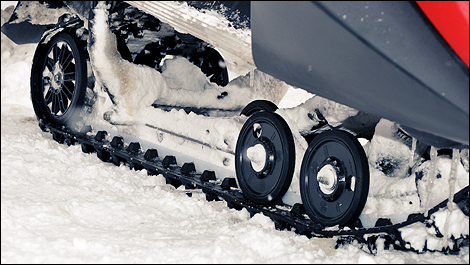 |
| Sending power to the ground is the excellent Ripsaw track with 1.25'' studs – arguably the best performance track around. (Photo: Pascal Bastien/Moto123.com) |
A bit of fine-tuning
The rider has to take time to properly set the suspension at all three points in order to create the desired weight transfers and make the Rush bend to his or her will. Only make one change at a time, though. Then, go out and see how the sled behaves. It's also easy to improve front-end handling by fitting a pair of Cobra Head plates from Qualipièces, which eliminate much of the darting by levelling snow before it touches the carbide runners.
Sending power to the ground is the excellent Ripsaw track with 1.25'' studs – arguably the best performance track around. Traction is never a problem even when fluffy snow covers the ice. Accelerations remain linear both on flats and inclines. What's more, the Rush Pro-R gets a lighter, flower-shaped, cross-drilled rotor that provides flawless braking power and precision.
Competent albeit smelly engine
The 600 Rush Pro-R gets the latest Cleanfire2 engine – a 600-cc, 2-stroke, twin-cylinder that produces an impressive 120 horsepower. Introduced on the IQ models, this little marvel of smoothness now benefits from advanced fuel injection technology to allow strong accelerations on par with the best 2-stroke powerplants in the industry. It's not the cleanest, however. While the engine meets EPA emission standards, it generates more oily smells than competitors.
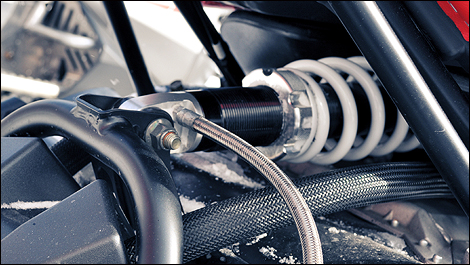 |
| The superior dynamics of the Pro-Ride chassis (compared with the previous architecture) essentially turn them into thrill-inducing machines. (Photo: Pascal Bastien/Moto123.com) |
On the other hand, the 800 Cleanfire mill of the Polaris 800 Rush Pro-R has been significantly revised to improve durability while reducing oil consumption, emissions and smells. Moreover, the mechanical oil pump (controlled by a rod instead of a wire) lubricates the internal components with greater precision.
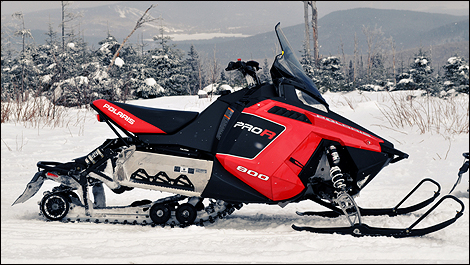 |
| The 2011 Polaris 600 Rush Pro-R and 800 Rush Pro-R now have all the tools to satisfy sporty trail riding enthusiasts. (Photo: Pascal Bastien/Moto123.com) |
In both cases, power is managed by the excellent CVT P2 system with variable-diameter pulley, also offering greater precision than ever. The unit's improvements help reduce the operating temperature and increase belt longevity as well.
Bottom line
The 2011 Polaris 600 Rush Pro-R and 800 Rush Pro-R now have all the tools to satisfy sporty trail riding enthusiasts. The superior dynamics of the Pro-Ride chassis (compared with the previous architecture) essentially turn them into thrill-inducing machines. The brand is certainly back in the race and we haven't seen everything yet. Stay tuned!
Plus
Powerful engine (600 and 800)
Highly-effective CVT P2 system
Improved Pro-Ride suspension
Superb ergonomics for active riding
Flawless braking performance
Less
Excessive oil smells
Front-end darting





